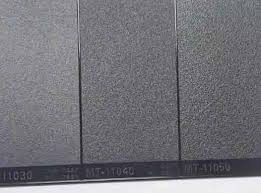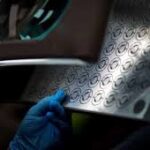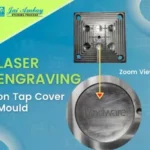
Automotive Mold Finishes are crucial for dictating the final surface quality of plastic car components produced through injection molding. These finishes go beyond mere aesthetics, influencing factors like grip, light reflection, wear resistance, and even the perceived quality of a vehicle’s interior and exterior.1 Selecting the appropriate mold finish is a detailed process that balances design requirements with manufacturing feasibility and cost considerations.
The Significance of Automotive Mold Finishes
The texture and smoothness imparted by the mold finish directly impact the look and feel of automotive parts.2 A high-gloss finish can create a sense of luxury and highlight design lines on exterior trim, while a textured surface on interior components can improve grip and reduce glare. Functionally, the mold finish can affect how easily a part releases from the mold, the adhesion of paint or coatings, and the component’s resistance to scratches and wear.3 Ultimately, the right mold finish contributes significantly to both the visual appeal and the long-term durability of automotive parts.
Common Types of Automotive Mold Finishes Automotive Mold Finishes
The automotive industry utilizes various standardized systems to specify mold finishes, with the SPI (Society of Plastics Industry) and VDI (Verein Deutscher Ingenieure) being the most prevalent.4 These standards categorize finishes based on the method used to achieve them and the resulting surface roughness or texture.5
Here’s a breakdown of common types:
- Polished Finishes (SPI A Grades): Achieved through meticulous abrasion using diamond buffing compounds. These finishes result in extremely smooth, high-gloss surfaces, often used for optical components like lenses and mirrors, as well as exterior trim requiring a premium look. Different sub-grades (A-1, A-2, A-3) denote varying levels of polish.
- Semi-Gloss Finishes (SPI B Grades): Created using fine-grit sandpaper. These offer a balance between gloss and a slight texture, effectively concealing minor machining marks. They are commonly used for interior parts where a subtle sheen is desired. Sub-grades (B-1, B-2, B-3) indicate different levels of gloss and texture.6
- Matte Finishes (SPI C Grades): Produced by sanding with grit stones.7 These finishes are non-reflective and provide a low-gloss appearance. They are often chosen for interior components to reduce glare or for surfaces where a more understated look is preferred. Sub-grades (C-1, C-2, C-3) offer varying degrees of matte texture.
- Textured Finishes (SPI D Grades & Mold-Tech/MT): Achieved through methods like bead blasting with various media (glass beads, aluminum oxide) or chemical etching. These finishes create a tactile surface that can improve grip, hide imperfections, and add visual interest (e.g., simulating leather or wood grain). Mold-Tech (MT) offers a vast library of specific textures with varying depths and patterns. Sub-grades within SPI D denote different levels of texture created by blasting.
- Other Techniques: Beyond these standards, other methods like Electrical Discharge Machining (EDM) can create unique textures, and satin finishes offer a smooth, non-glossy look achieved through gentle abrasion.
Achieving Automotive Mold Finishes
The desired surface finish is typically imparted to the mold cavity during the mold-making process itself. This ensures that every part molded using that tool will replicate the specified finish. The techniques employed include:
- Polishing: Skilled technicians use rotary tools and progressively finer abrasive compounds, including diamond pastes, to achieve mirror-like or high-gloss surfaces.
- Sanding: Manual sanding with various grits of sandpaper or grit stones creates semi-gloss or matte finishes with controlled roughness.
- Bead Blasting: High-pressure streams of abrasive media are directed at the mold surface to create uniform textured finishes. The type and size of the media influence the resulting texture.
- Chemical Etching: Controlled application of chemicals to the mold surface selectively removes material, creating intricate textures and patterns.
- Electrical Discharge Machining (EDM): Electrical sparks erode the mold surface, allowing for the creation of complex and precise textures.8
- Laser Etching: A precise laser beam ablates the mold material to create detailed textures and engravings.9
Key Considerations for Selecting Mold Finishes
Choosing the appropriate automotive mold finish involves several factors:
- Aesthetic Requirements: The desired visual appearance of the part, including gloss level, texture, and any specific patterns.
- Functional Requirements: The need for grip, reduced glare, wear resistance, paint adhesion, or ease of demolding.10
- Material Compatibility: Different plastics react differently to various finishing techniques. Some materials may not replicate fine textures well, while others might be prone to showing imperfections with high-gloss finishes.
- Part Design: Complex geometries, including deep ribs or intricate features, can make achieving uniform finishes more challenging. Draft angles are also crucial for textured parts to ensure proper release without damaging the finish.11
- Manufacturing Cost: Higher-gloss and complex textured finishes often require more time and skilled labor, increasing production costs.12
- Industry Standards: Adherence to specific automotive industry standards for interior and exterior finishes.13
In conclusion, automotive mold finishes are a critical aspect of producing high-quality and visually appealing plastic car components.14 By carefully considering the aesthetic and functional requirements, material properties, and manufacturing processes, engineers and designers can select the ideal mold finish to meet the specific demands of each automotive application.



